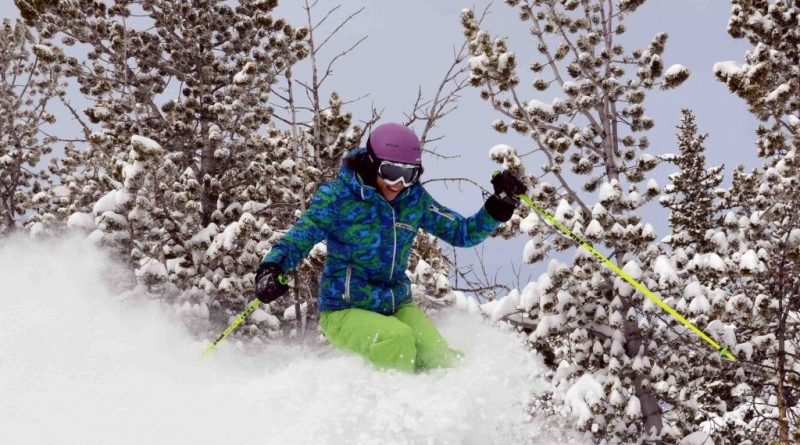5 Keys to Skiing Powder
Think you know everything there is to know about skiing powder? Here are a couple more things to keep in mind.
By Lisa Densmore Ballard
A number of years ago, John Egan, Director of Fun at Sugarbush Resort, and I paused briefly at the top of a steep slope covered with 18 inches of new snow. “Do you know the first rule of powder skiing?” he asked, with a twinkle in his eyes, “Be first!”
With that, he catapulted onto the pristine piste, hooting with pleasure. I cursed him for his brash hogging of the virgin snow, then laughed with delight as I followed him through thigh-deep drifts, our tracks crisscrossing to form perfect 8’s behind us.
John and I are both powder hounds, skiers in dogged pursuit of the crystalline champagne that falls from the sky and blankets the ski slopes. It doesn’t happen often in Vermont, but when a Nor ‘easter hits, John’s advice, to be first, is worth taking to heart. That is, if you like skiing ungroomed snow. For many, powder is more a leg-frying exercise in frustration than weightless nirvana.
Skiing powder with aplomb takes some adjustments to your technique. Choice of terrain matters, too. Here are five tips to help you become a powder hound:
1. Stay centered. In the old days, we used to sit back in powder to keep our tips up, but modern skis, with their wide tips, naturally stay up. They also perform better if you stay centered. If the snow is heavy, it helps to emphasize unweighting during the transition between turns rather than sitting back.
2. Choose steeper terrain. Powder causes friction against your legs which slows you down and can feel like a drag on a slope on which you normally have plenty of speed. A steeper slope helps you maintain your momentum. Gravity does the work rather than your legs. On a powder day, trails that normally seem steep and challenging suddenly have the perfect pitch.
3. Make shorter turns. A short-radius turn is your friend on a powder day. Though big turns can also be fun, they come with a higher chance of getting off-balance. When making shorter turns, your torso should face down the hill. Be sure to use a pole plant every turn, well, pole “touch”. If you plant your pole too hard, it might sink in too far, potentially causing a fall.
4. Use a neutral (narrow) stance. Keep your feet about hip width apart, no wider or narrower. When your feet are hip-width apart, your skis form a platform in the snow which helps you feel balanced and more relaxed. If your feet are too wide, each ski becomes more independent and thus more likely to catch and spin you off your line. If your feet are glued together, you won’t be as agile and your hips will likely drift behind your feet causing severe leg burn.
5. Put weight on both skis. In Vermont, where snow conditions are often firm, we’re programmed to put most of our weight on the outside (downhill) ski to create better edge grip. What’s more, high performance turns on the groomers require pronounced angulation (the legs go side to side while the torso stays quiet and upright). In powder, it’s better to distribute your weight about 60 percent to the outside ski and 40 percent to the inside ski. Back off on the body angles, too. The most graceful powder skiers still roll their feet from side to side but with a steady finesse rather than powerful pressure.
Powder Skis
Most skiers know the fatter your skis are, the more float they give you in powder. However, with the trend over the last decade toward increasingly wider skis, a ski’s footprint is no longer the only thing that matters. The perfect powder ski has these attributes:
• Width: Waist greater than 90 mm. Many powder skis are much wider, over 110mm, but if you’re skis are at least 90 mm, you’re in the realm of fat skis.
• Rocker: If the ski has at least tip rocker or pre-bending in the front of the ski (sometimes called “early rise”), it tends to ride up in the snow rather than plow it.
• Length: Most powder skis are much longer (10 – 30 cm. longer) than skis designed for the groomers depending on your weight and ability level. The extra length gives you more buoyancy, and if they are rockered, they feel much shorter because the effective running surface is less than the measured length of the ski.
A former member of the U.S. Ski Team and a long-time Vermont skier, Lisa Densmore Ballard is the founder and host of the “Your Turn” women’s ski events and pro days. Her favorite days on skis are powder days! www.LisaDensmore.com.
Featured Photo Caption: Densmore Ballard finds a powder stash on a bluebird day in Vermont. Photo courtesy Lisa Densmore Ballard.

